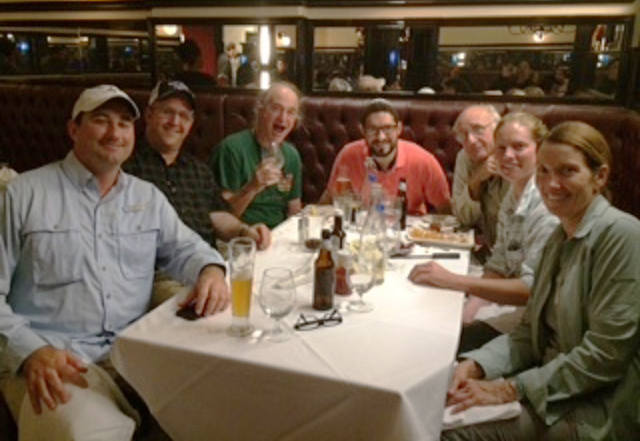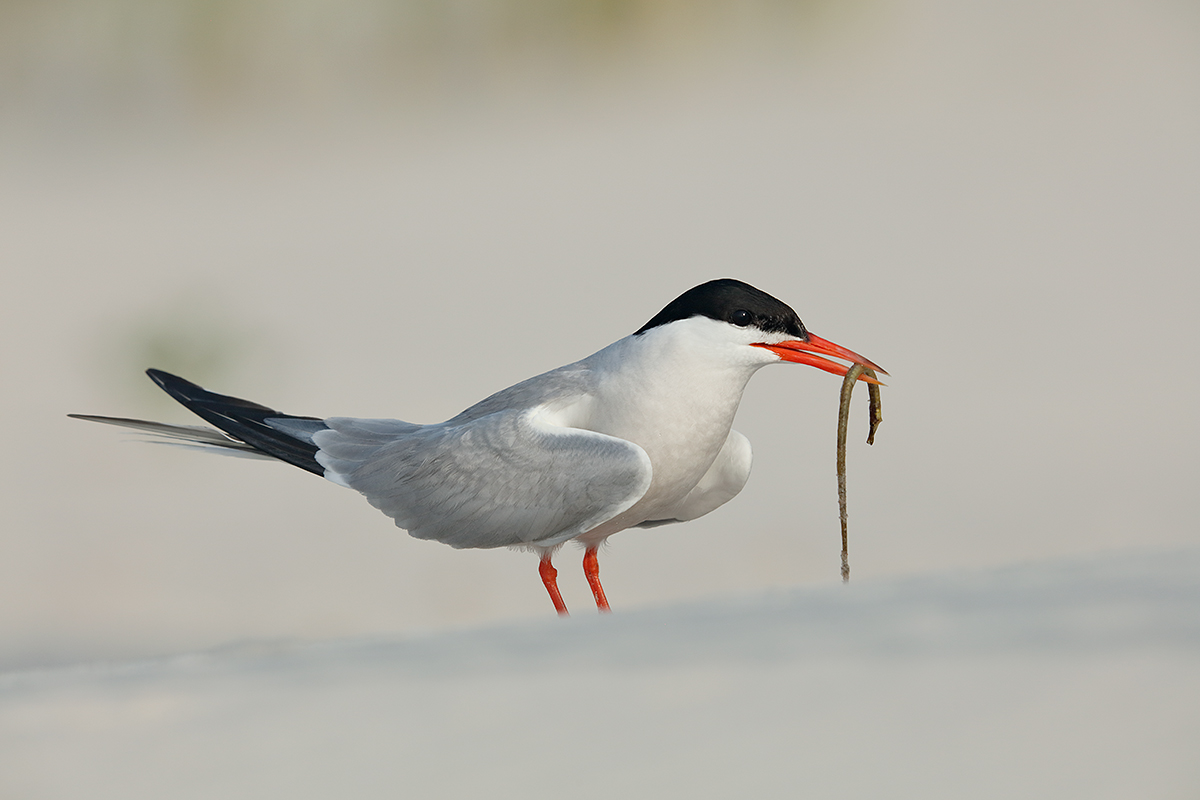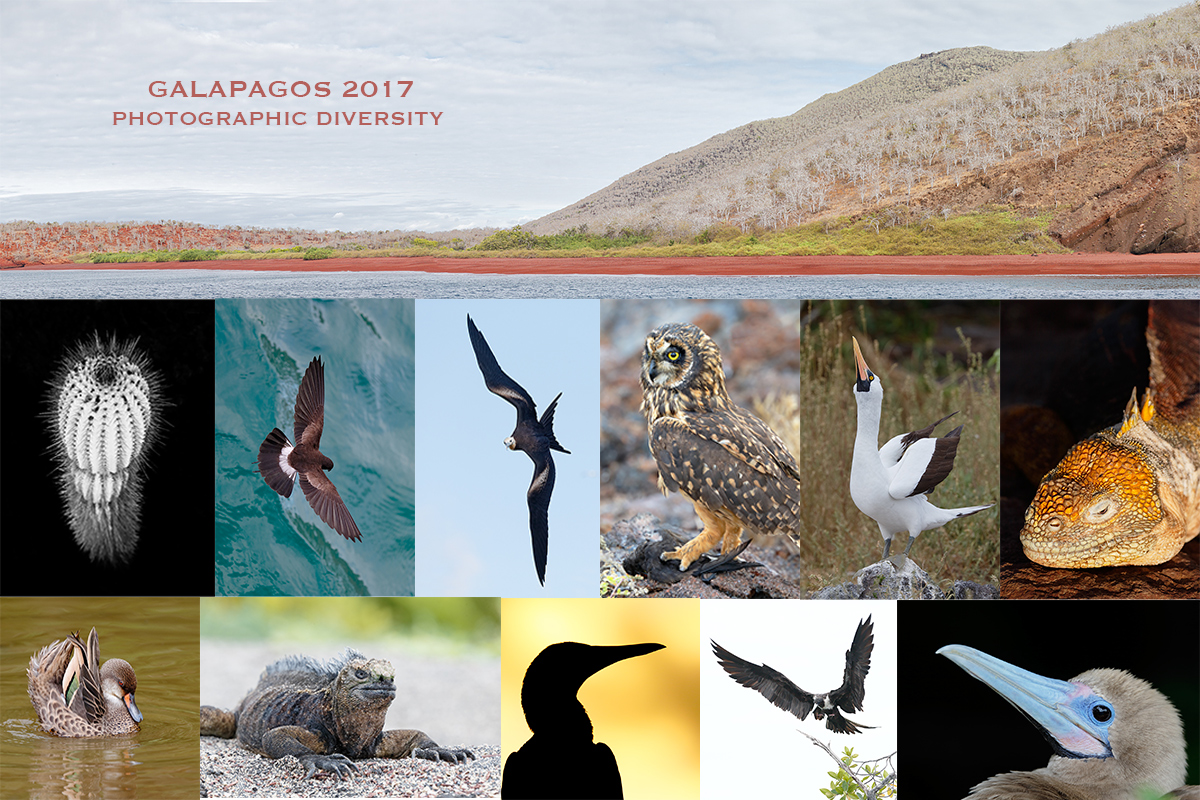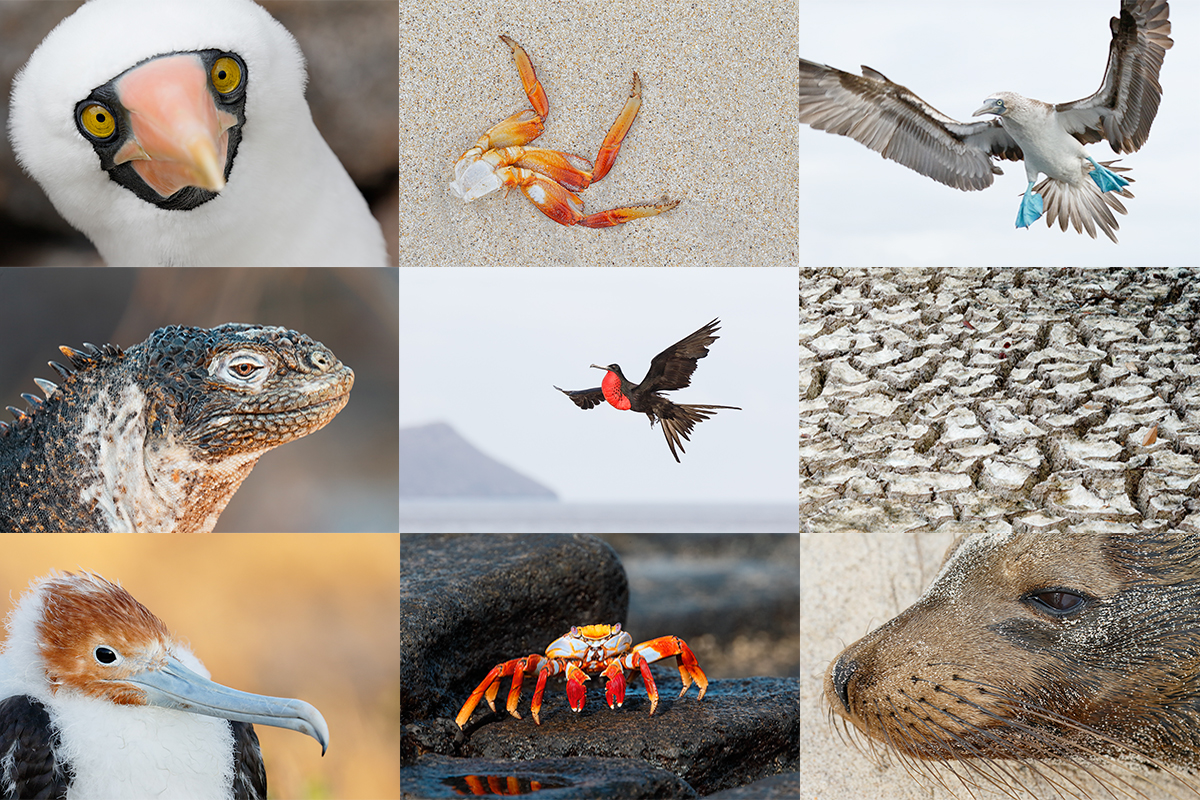What’s Up?
On Thursday afternoon Izzy Flamm–B&H Senior Marketing Campaign Manager, and his sidekick, Yosef Brown–Manager, Strategic Partnerships, Affiliate Partners, Content Partners, & Industry Influencers, drove from Manhattan to Nickerson Beach to cool off, enjoy the birds, and meet my IPT group. They generously offered to take everyone out for dinner. We drove about 25 minutes to Prime Bistro, a kosher French Steakhouse, Brasserie & Butchery in Lawrence, Long Island, NY. The food was amazing and we had a blast. Melody Goetz–the restaurant manager who took our orders, was so funny that within a minute of her stand-up routine, I asked her if she had here own TV show. Her humor was strong and in your face, a blend of Phyllis Diller and Joan Rivers with short dark hair. Best of all, the food was superb. Huge thanks to Izzy and Yosef and the rest of the gang at B&H.
|
From left to right: Will Schilling, Izzy Flamm, yours truly, Joef Brown, Michael DeRosa, Elizabeth MacSwan, and Kerry Morris. Photo by Melody Goetz with Josef Brown’s cell phone…. The IPT group and our hosts having huge fun at Prime Bistro |
We did not get back to the IPT hotel until after 11pm so we moved back our start time an hour. With early morning clouds but no sunrise color we did just fine (as seen below by today’s featured image).
Getting Lazy
Please remember that the blog is a better place to be when it is interactive. Folks have gotten very lazy recently. Please consider going back to yesterday’s blog post and let us know which of the three chick images was your favorite. And why. I do honestly want to hear your opinions. The more folks participate the more learning takes place…
The Streak
Today’s blog post marks a totally insane, absurd, completely ridiculous, unfathomable, silly, incomprehensible, what’s wrong with this guy?, makes-no-sense, 255 days in a row with a new educational blog post. And I still have dozens of new topics to cover; there should be no end in sight until my big South America trip next fall. As always-–and folks have been doing a really great job recently–-please remember to use our B&H links for your major gear purchases. For best results use one of our many product-specific links; after clicking on one of those you can continue shopping with all subsequent purchases invisibly tracked to BAA. Your doing so is always greatly appreciated. Please remember: web orders only. AND Please remember also that if you are shopping for items that we carry in the new BAA Online Store (as noted in red at the close of this post below) we would appreciate your business.
|
This image was created on the last morning of the 2016 Nickerson Beach IPT with the Induro GIT 304L/Mongoose M3.6-mounted Canon EF 600mm f/4L IS II USM lens, the Canon Extender EF 2X III, and the mega mega-pixel Canon EOS 5DS R.. ISO 400. Evaluative metering +2/3 stop as framed: 1/500 sec. at f/11 was about 2/3 stop under-exposed. AWB. Center AF point (by necessity)/AI Servo Expand/Shutter Button AF as framed was active at the moment of exposure. Click on the image to enjoy a larger version. LensAlign/FocusTune micro-adjustment: -5. Common Tern with pipefish for young |
A Different Approach to Bird Photography
My basic approach to bird photography has long been walk and stalk.
Dear friends (the late) Max and Nellie Larsen used to bird the East Pond at my beloved Jamaica Bay Wildlife Refuge by heading out with two small folding chairs, parking themselves in one spot, and never moving. They used to say, “Stay in one spot and all the birds will come to you.” Max, who has been gone for five years, made it to 93. Nellie will be 95 in November; she is living in the hills of Pennsylvania. The Larsens were very kind to me when I began birding in 1977 and I cherish the memories of the time I spent in the field with them.
On Friday morning we had wind against sun once again. Sun in the east, the wind at 15 from the southwest. Doomsday for bird photography with all the birds facing away from us. As there were no oystercatchers feeding in the surf, our best chance for success was to photograph the Common Tern chicks waiting to be fed. We had the sun behind us and the wind in our faces. The adults with fish would fly in over our heads facing away. But the eager chicks would be facing right at us as they awaited the incoming parents: the eager chicks wanted to be able to see to the west to check for momma or poppa and they would often wind up square to the light and square to the backs of our cameras.
So how did I pick the spot for us to sit and wait? There was a snow fence and several chicks from two nests were hanging out by it. The area to the right of the fence was a bit overgrown. To the left there was lots of clean sand with only a few small beach plants. Farther to the left the beach was littered with small bits of shell. So we sat about five yards south of the snow fencing and simply waited for the action to come to us. It was not non-stop but we had lots of great chances. Including the adult with a pipefish that is today’s featured image. IPT veteran Will (The Thrill) Schilling nailed a begging chick with his 600 II, his 2X III TC, and the 5DS R that he rented from me for the workshop. That image will be featured here soon.
Sometimes You Just Gotta Pull the Trigger…
While it is ideal to have the active sensor on the bird’s eye or face, or have enough time to rear focus and re-compose, there are times-especially when restricted to the center AF point–that you cannot afford such luxury. You often need to focus and fire. When the tern landed just behind the sand ridge I acquired focus near the rear of the bird and created a single image with the bird too far forward in the frame. I pointed the camera right with the sensor on the bird above the bend of the wing. But the tern’s headed was turned away from me a bit: poor head angle. Frame three, today’s featured image was bingo. In frame four the bird was centered and the position of the pipefish was less than ideal. With frame five, the bird’s head was turned too much toward me; with the sun from my right the right side of the bird’s face was in shadow and the shadow of the pipefish fell unpleasingly on the bird’s breast.
Sometimes you just gotta pull the trigger and hope for the best…
Critique
Critique today’s featured image if you like. Note: good critiques include positives, negatives, and suggestions.
|
Tame birds and wildlife. Incredible diversity. You only live once… |
GALAPAGOS Photo Cruise of a Lifetime IPT/The Complete Galapagos Photographic Experience. August 8-22, 2017 on the boat. 13 FULL and two half-days of photography: $12,499. Limit: 13 photographers plus the leader: yours truly. Openings: 4.
Same great trip; no price increase!
This trip needs nine to run; in the unlikely event that it does not, all payments to BAA will be refunded in full.
My two-week Galapagos Photo-Cruises are without equal. The world’s best guide, a killer itinerary, a great boat (the Samba), and two great leaders with ten Galapagos cruises under their belts. Pre-trip and pre-landing location-specific gear advice. In-the-field photo instruction and guidance. Jeez, I almost forgot: fine dining at sea!
The great spots that we will visit include Tower Island (including Prince Phillips Steps and Darwin Bay), Hood Island (including Punta Suarez, the world’s only nesting site of Waved Albatross, and Gardner Bay)—each of the preceding are world class wildlife photography designations that rank right up there with Antarctica, Africa, and Midway. We will also visit Fernandina, Puerto Ayora for the tortoises, Puerto Egas—James Bay, and North Seymour for nesting Blue-footed Boobies in most years, South Plaza for Land Iguanas, Floreana for Greater Flamingoes, and Urbina Bay, all spectacular in their own right. We visit every great spot on a single trip. Plus tons more. And there will be lots of opportunities to snorkel on sunny mid-days for those like me who wish to partake.
It is extremely likely that we will visit the incredible Darwin Bay and the equally incredible Hood Island, world home of Waved Albatross twice on our voyage. The National Park Service takes its sweet time in approving such schedule changes.
We will be the first boat on each island in the morning and the last boat to leave each island every afternoon. If we are blessed with overcast skies, we will often spend 5-6 hours at the best sites. And as noted above, mid-day snorkeling is an option on most sunny days depending on location and conditions. On the 2015 trip most snorkeled with a mega-pod of dolphins. I eased off the zodiac to find hundreds of dolphins swimming just below me. Note: some of the walks are a bit difficult but can be made by anyone if half way decent shape. Great images are possible on all landings with either a hand held 70-200mm lens and a 1.4X teleconverter or an 80- or 100-400. I sometimes bring a longer lens ashore depending on the landing. In 2017 I will be bring the Canon 400mm IS DO II lens. In the past I have brought either the 300mm f/2.8L IS II or the 200-400mm f/4 L IS with Internal Extender.
|
Do consider joining me for this once in a lifetime trip to the Galapagos archipelago. There simply is no finer Galapagos photography trip. Learn why above. |
An Amazing Value…
Do know that there are one week Galapagos trips for $8500! Thus, our trip represents a tremendous value; why go all that way and miss half of the great photographic locations?
The Logistics
August 6, 2017: We arrive in Guayaquil, Ecuador a day early to ensure that we do not miss the boat in case of a travel delay.
August 7, 2017: There will be an introductory Galapagos Photography session and a hands on exposure session at our hotel.
August 8, 2017: We fly to the archipelago and board the Samba. Heck, on the 2015 trip some people made great images at the dock in Baltra while our luggage was being loaded!
August 22, 2017: We disembark late morning and fly back to Guayaquil midday; most will overnight there.
Most will fly home on the early morning of July 23 unless they are staying on or going elsewhere (or catching a red-eye flight on the evening of the 22nd).
$12,499 includes just about everything: all transfers, guide and park fees, all food on the boat, transfers and ground transportation, your flights to the archipelago, and three nights (double occupancy) in a top notch hotel in Guayaquil. If you are good to go, a non-refundable deposit of $5,000 per person is due immediately. The second payment of $4,000 is not due until 11/1/16. The final payment of $3449 per person will be due on 2/1/17. A $200 discount will be applied to each of the balances for couples or friends who register at the same time.
Purchasing travel insurance within 2 weeks of our cashing your deposit check is strongly recommended. On two fairly recent cruises a total of 5 folks were forced to cancel less than one week prior to the trip. My family and I use Travel Insurance Services and strongly recommend that you do the same.
Not included: your round trip airfare from your home to and from Guayaquil, beverages on the boat, phone calls, your meals in Guayaquil, personal items, and a $600/person cash tip for the crew and the guide—this works out to roughly $40/day to be shared by the 7 folks who will be waiting on us hand and foot every day for two weeks. The service is so wonderful that many folks choose to tip extra.
Please e-mail for the tentative itinerary or with questions. Please cut and paste “Galapagos 2017 Tentative Itinerary Please” into the Subject line.
Please Remember to use our Affiliate Links and to Visit the New BAA Online Store 🙂
To show your appreciation for my continuing efforts here, we ask, as always, that you get in the habit of using my B&H affiliate links on the right side of the blog for all of your photo and electronics purchases. Please check the availability of all photographic accessories in the New BIRDS AS ART Online Store, especially the Mongoose M3.6 tripod head, Wimberley lens plates, Delkin flash cards and accessories, and LensCoat stuff.
As always, we sell only what I have used, have tested, and can depend on. We will not sell you junk. We know what you need to make creating great images easy and fun. And we are always glad to answer your gear questions via e-mail.
I would of course appreciate your using our B&H affiliate links for all of your major gear, video, and electronic purchases. For the photographic stuff mentioned in the paragraph above we, and for everything else in the new store, we, meaning BAA, would of course greatly appreciate your business. Here is a huge thank you to the many who have been using our links on a regular basis and those who will be visiting the New BIRDS AS ART Online Store as well.
Be sure to like and follow BAA on Facebook by clicking on the logo link upper right. Tanks a stack!
Typos
In all blog posts and Bulletins, feel free to e-mail or to leave a comment regarding any typos or errors. Just be right 🙂


















I love the image as well. The lighting on the bird is amazing. However, I with others that removing the discoloration around the birds tail might help somewhat. Also, for me, you might have been a little too tight on the bird. I would have liked to have a little more image to his right. The tern seems to be a little too centered. But the texture of the photo is wonderful.
Thanks Frank. I just may do a repost without the suffused green. I am fine with the size of the bird in the frame. I teach “a whole bird should never take up more than 75% of either dimension of the frame.” As here. As for the tern being too centered, I teach: “Have about 3-5 times as much room from the bill tip to the frame edge as from the tip of the tail to the frame edge.” Again, as here 🙂
A bit more room on the right would have been nice but there as a snow fence right there…
love to you and to Laurie,
a
I agree with Catherine about the softness around the bird and don’t mind the hidden feet. Seeing the eye is another plus. Lighting and color are gorgeous. The one thing I would like different would be to remove the dark blotch behind the tail. Looks as if it is a plant like the ones at the top, which I do like.
Hi Art
Greetings
I love the low angle and the exposure. The light out of focus behind the terns tail feather makes me feel that removing it may look better. That’s only me though.
Do you mean the suffused area of green?
a
Hi Art
Yes that is the area I was referring to.
I’m with Catherine. Love the low angle and soft edge that provides the needed teaser for the feet.
This is a wonderful image. I especially love the softness that surrounds the bird and makes the bird really stand out. Not seeing the feet does not bother me.
Hi, Artie. Love the image–exposure, composition, and you can see the bird’s eye, which is a challenge for terns in breeing plumage. But I wish I could see its lovely, orange, clawed feet. If you had got higher, would that have wrecked the background?
Thanks David, I would have loved it had the bird landed on the crest of the ridge so that we could have seen its feet. If I had tried to have gotten higher, I would have not gotten a single image as I knew that it was only staying a few seconds at most. And, doing so would have ruined the image; it is the low angle that yields the lovely soft BKGR.
a
ps: the concepts here are taught quite a bit on the UK Puffins IPT.